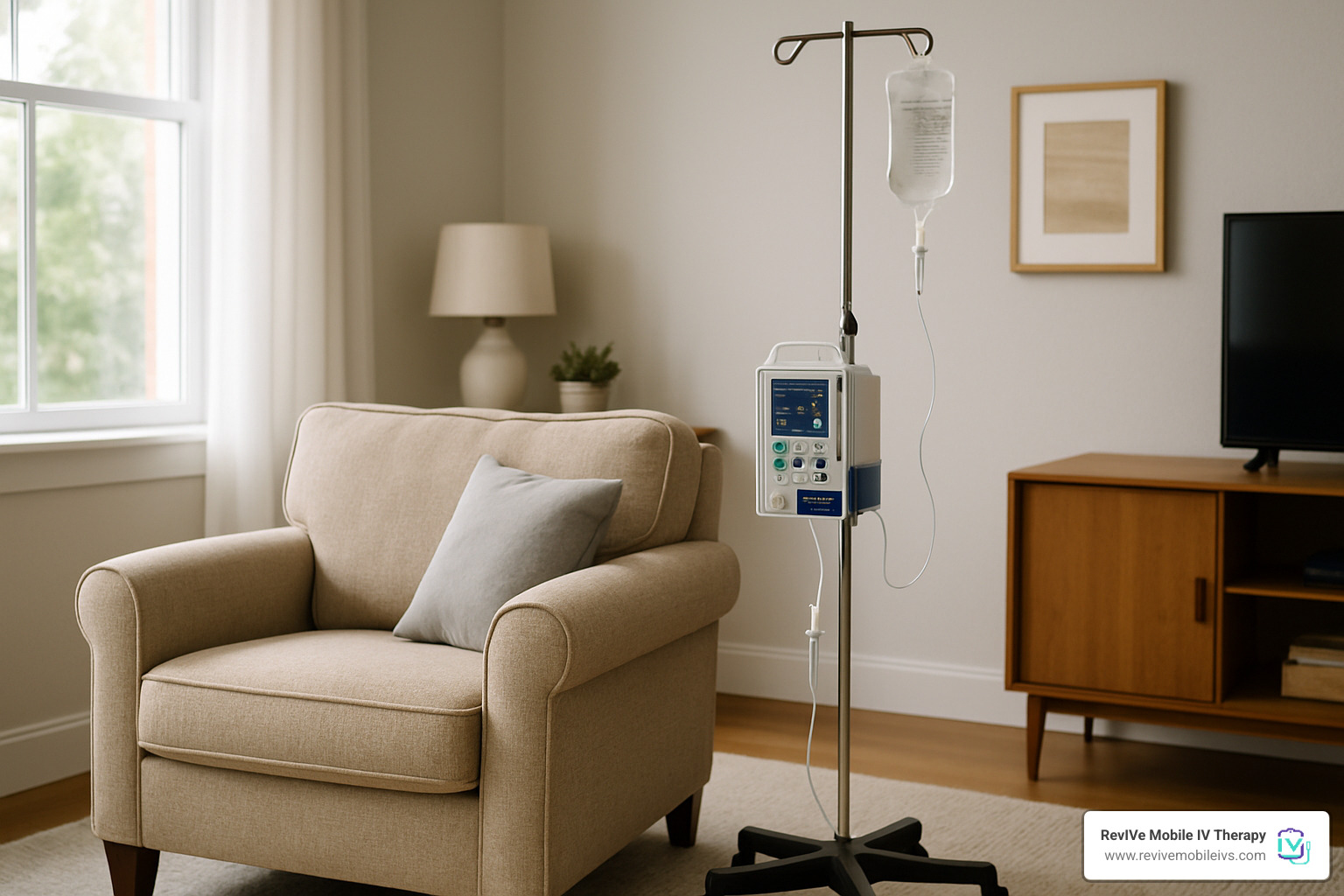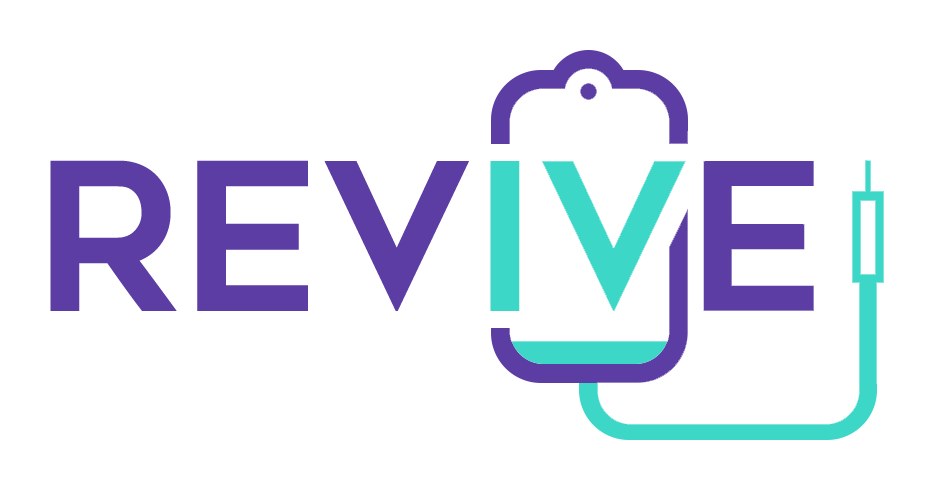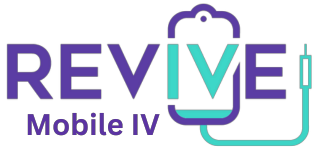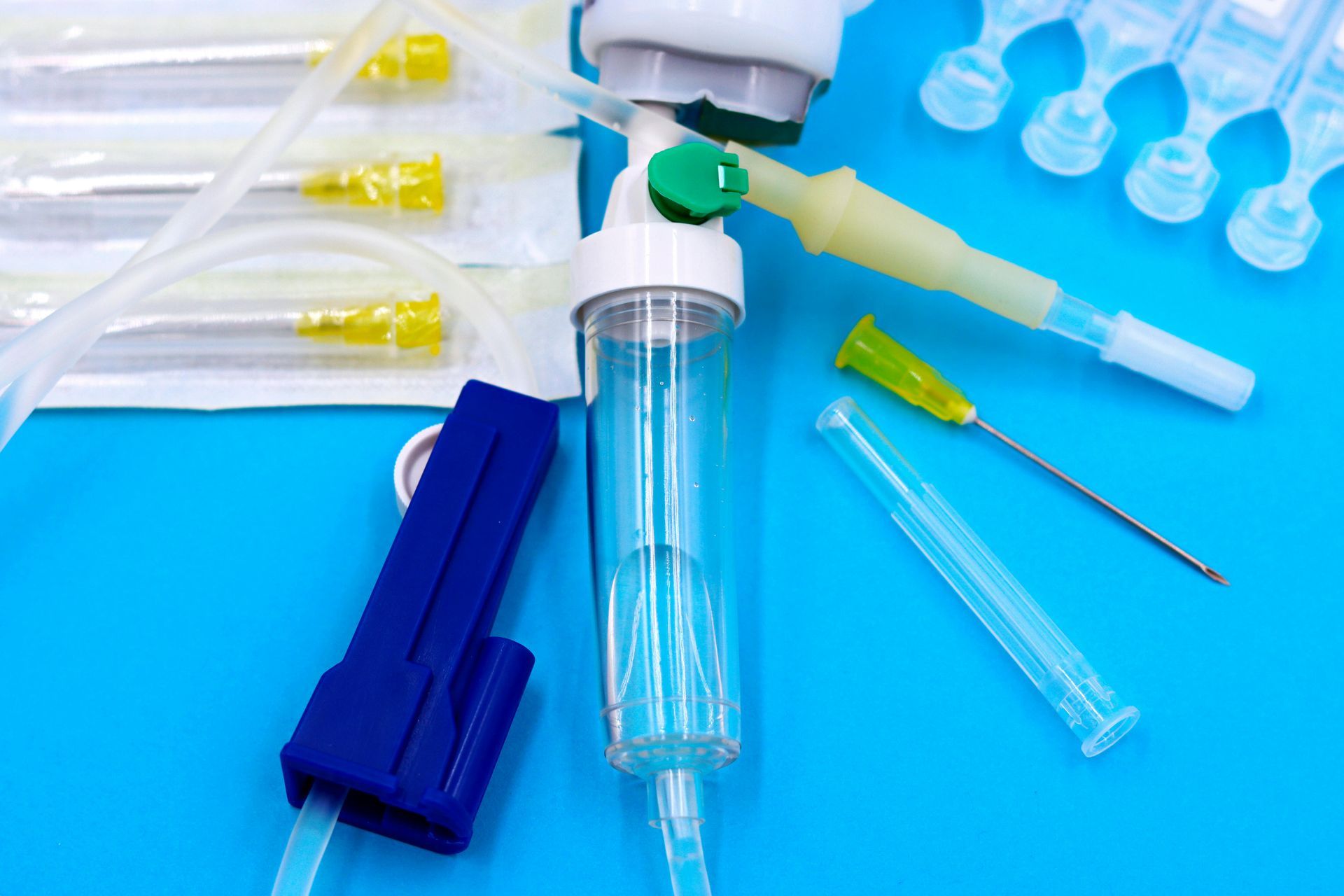Home IV Infusion Therapy: Drip, Sip, and Chill
Why Home IV Infusion is Changing Healthcare Delivery
Home iv infusion therapy allows patients to receive intravenous medications, fluids, and nutrients in the comfort of their own homes rather than in hospitals or clinics. This medical service delivers everything from antibiotics and chemotherapy to hydration and nutritional support through a trained healthcare team.
Key Benefits of Home IV Infusion:
- Convenience- No travel time, waiting rooms, or disrupted schedules
- Safety- Reduced risk of hospital-acquired infections
- Cost-effective- Often more affordable than inpatient treatment
- Comfort- Maintain daily routines in familiar surroundings
- Quality care- Administered by licensed nurses with physician oversight
The home infusion market has exploded in recent years. Over 3 million patients receive home or alternate-site infusion therapy annually in the United States. This growth reflects both advancing medical technology and patient preference for receiving care at home.
Most commonly, people need home IV infusion for serious infections requiring high-dose antibiotics. But the therapy also supports cancer patients, those with immune deficiencies, chronic pain sufferers, and people needing nutritional support or hydration.
Medicare now covers home infusion therapy-associated professional services under Section 5012 of the 21st Century Cures Act, making this option more accessible than ever before.
I'm Kylee Heck, co-founder of RevIVe Mobile IV Therapy, and I've personally overseen over 3,000 home iv infusion sessions across Pennsylvania since 2023. My experience has shown me how transformative convenient, physician-led IV therapy can be for busy professionals who need effective treatment without the hospital hassle.
Understanding Home IV Infusion Therapy

Home iv infusion brings hospital-quality IV treatment directly to your living room. Instead of sitting in a sterile medical facility for hours, you receive the same high-quality intravenous therapy while relaxing at home.
Medications, fluids, or nutrients flow directly into your bloodstream through a small needle or catheter placed in your vein. This direct delivery system bypasses your digestive system entirely, achieving 100% medication absorption- compared to oral pills that often only achieve 20% absorption rates.
According to Scientific research on safety , home infusion proves just as safe and effective as hospital-based treatment for many conditions.
How home iv infusion works step-by-step
Your journey begins when your doctor writes a detailed prescription specifying exactly what you need, how much, and when you should receive it.
A skilled nurse visits your home to establish IV access, either through a peripheral catheter in your arm for short-term treatments or a central line for longer therapy. Your prescribed medications undergo sterile compounding at a specialized pharmacy meeting strict USP 797 standards.
When it's time for your infusion, the delivery method depends on your medication. Some treatments use simple gravity flow with the IV bag hanging above you, while others require an ambulatory pump that precisely controls the infusion rate.
Common medications in home iv infusion bags
The most common reason people need home iv infusion is for IV antibiotics to treat serious infections like osteomyelitis or sepsis that won't respond to oral antibiotics.
Total Parenteral Nutrition (TPN) provides complete nutritional support when digestive systems can't handle food normally. Immunoglobulin therapy delivers antibodies to boost weakened immune systems.
For chronic conditions like rheumatoid arthritis or Crohn's disease, biologics offer targeted treatment. Hydration fluids help maintain proper fluid balance, while cancer patients often receive chemotherapy at home.
Home iv infusion vs clinic infusion
The difference comes down to convenience, infection risk, and cost. Home treatment eliminates travel time, waiting rooms, and hospital-acquired infection exposure. You can work, rest, or spend time with family during treatment while typically saving 50-70% compared to hospital-based care.
Who Qualifies and What Can Be Treated?
Deciding who's right for home iv infusion therapy requires careful evaluation by your physician. You need to be stable enough to be away from constant medical supervision, but sick enough to actually need IV therapy.
Your home environment gets assessed for basic necessities like reliable electricity, adequate lighting, and space to store medical supplies. One of the biggest factors is whether you or someone in your household can handle the responsibility and training required.
Medical conditions benefiting from home iv infusion
Osteomyelitis and other serious bone infections are the most common reason people need home IV therapy. These stubborn infections need weeks of high-dose antibiotics.
Crohn's disease and other inflammatory bowel conditions often require IV medications when your digestive system isn't cooperating. Dehydration from conditions like severe morning sickness or certain cancers can be managed with regular IV fluid treatments.
Cancer therapy has advanced significantly, with many chemotherapy treatments now safely administered at home. Pain management through continuous IV infusions helps people with complex regional pain syndrome when oral medications aren't sufficient.
Patient selection & caregiver readiness
Success often comes down to cognitive ability to understand treatment, recognize problems, and know who to call for help. Caregiver availability means having someone mentally present, capable of learning medical procedures, and ready to take on real responsibility.
Both patients and caregivers must complete training on aseptic technique, flushing IV lines properly, and troubleshooting equipment alarms. Motivation and compliance matter - following strict protocols requires dedication.
Contraindications to home iv infusion
Unstable vital signs or conditions requiring frequent monitoring mean you need immediate medical availability. High infection risk scenarios sometimes require hospital isolation and intensive monitoring.
Poor venous access requiring multiple attempts or specialized procedures makes home therapy impractical. An unsafe home environment lacking basic infrastructure or lack of support combined with inability to self-manage creates impossible situations.
Setting Up Safe Home Infusions: People, Equipment, and Training
Your equipment kit becomes part of your daily routine. The DME pump ensures your medication flows at exactly the right rate and alerts you if anything needs attention. IV tubing connects your medication bag to your IV access point, while specialized dressings keep your IV site clean and secure.
You'll also receive alcohol swabs, gauze, tape, and other supplies for daily site care, plus an emergency kit with everything needed to handle common situations. Your pharmacy coordinates all deliveries and ensures you have everything before your first treatment.
More info about Home IV Service explains how we handle the logistics so you can focus on healing.
The care team behind every home iv infusion
Your physician remains the conductor, prescribing therapy, monitoring progress, and staying available for questions. Pharmacists compound your treatments in sterile environments meeting strict USP 797 standards, ensuring medications are properly mixed and safe for home use.
Your nurses bring clinical expertise directly to your home. These professionals typically have backgrounds in emergency rooms or critical care with specialized infusion training. Family caregivers often become the unsung heroes, providing daily support and emotional encouragement.
Training patients & caregivers for success
Learning to manage your home iv infusion might feel intimidating initially, but most patients feel confident after just a few training sessions. Aseptic technique becomes second nature once you understand why it matters for preventing infections.
You'll learn to operate your infusion pump like a pro, change IV bags, manage tubing connections, and respond to alarms. Daily site care involves checking your IV site for problems and changing dressings when needed.
Medication handling includes proper storage, preparation, and administration. Most patients complete training in 2-3 sessions with plenty of hands-on practice.
Supply delivery & storage logistics
Most pharmacies deliver bi-weekly shipments that arrive like clockwork, timed with your treatment schedule. Cold chain management keeps temperature-sensitive medications properly chilled from pharmacy to your home.
Your sharps disposal system keeps everyone safe with certified containers your pharmacy provides and replaces regularly. Supply tracking becomes routine with automatic refill services and simple weekly inventory checks.
Benefits, Risks, and Quality Assurance
The real-world impact of home iv infusion therapy goes far beyond convenience. Cost savings represent one of the most compelling advantages - research shows home infusion costs 50-70% less than equivalent hospital treatment, meaning lower copays and out-of-pocket expenses.
Quality of life improvements are immediately noticeable. You can sleep in your own bed, eat your own food, and maintain daily routines. Many patients continue working during treatment, especially when receiving antibiotics or hydration therapy.
Infection prevention provides critical safety advantages. Hospital-acquired infections affect hundreds of thousands of patients yearly. Scientific research on reduced exposure confirms that home treatment eliminates this risk entirely.
Treatment outcomes for home infusion match or exceed hospital-based care for appropriate conditions, with some studies showing faster recovery times due to reduced stress and better sleep quality.
| Comparison Factor | Home Infusion | Hospital Infusion |
|---|---|---|
| Average Daily Cost | $200-400 | $800-1,500 |
| Infection Risk | Minimal | 3-5% hospital-acquired infection rate |
| Patient Satisfaction | 95%+ satisfaction rates | 70-80% satisfaction rates |
| Scheduling Flexibility | Complete control | Limited to hospital availability |
| Family Involvement | Full participation | Restricted visiting hours |

Key advantages you'll feel at home
Privacy and dignity matter when dealing with illness. Receiving treatment in your own clothes, in your own space, without constant hospital interruptions, helps maintain your sense of self.
Routine continuity supports both physical and mental healing. You maintain normal sleep schedules, regular meals, and daily activities around treatment. Family support becomes truly meaningful when loved ones can be present throughout treatment.
Potential complications & how to manage them
Phlebitis shows up as redness, warmth, or tenderness along your IV site. Stop the infusion immediately and contact your healthcare team. Infiltration happens when IV fluid leaks into surrounding tissue - you'll notice swelling and discomfort.
Allergic reactions range from mild skin reactions to serious symptoms. Mild reactions might only require antihistamines, but difficulty breathing, widespread rash, or feeling faint requires immediate emergency care.
Equipment issues like pump alarms usually have simple solutions covered in your training. Infection signs include fever over 100.5°F, chills, increasing redness, or drainage at your IV site - these require immediate medical attention.
Ensuring safety through standards & accreditation
Quality home iv infusion providers maintain strict safety standards through accreditation from organizations like The Joint Commission or ACHC. USP 797 compliance ensures medications are prepared in sterile environments following the highest pharmaceutical standards.
24/7 support means you're never alone with questions, while continuous monitoring through regular nurse visits and physician oversight often provides more consistent care than hospital stays.
Costs, Insurance, and Finding a Provider
Understanding home iv infusion costs can feel overwhelming, but most patients find it significantly more affordable than hospital treatment. The biggest game-changer came with Medicare Section 5012 of the 21st Century Cures Act, effective January 1, 2021, establishing Medicare coverage for home infusion therapy professional services.
Medicare now covers: Part B services including professional nursing visits, patient training, and monitoring; Part D covering prescription medications; and the DME benefit for infusion pumps and equipment. Scientific research on Medicare coverage offers detailed provider enrollment information.
Insurance pathways & alternative payment options
Medicare Advantage plans often provide better coverage than traditional Medicare. Private insurance typically covers home infusion as a medical benefit using per-diem reimbursement. Government programs like Medicaid and TRICARE generally cover medically necessary home infusion.
FSA and HSA accounts can pay for home infusion therapy, providing tax advantages on out-of-pocket costs. Many providers also offer financial assistance programs or payment plans for patients facing coverage gaps.
Budgeting for supplies, nursing, and drugs
Most insurers use per-diem models bundling all services into daily rates. Nursing services typically run $100-200 per visit, daily supplies cost $25-75 per day, and equipment rental averages $50-100 daily.
Medications vary wildly - basic antibiotics might add $50-100 per day, while specialized biologics can cost thousands. With insurance, most patients pay 10-20% of total costs through copays and deductibles.
How to choose a qualified home iv infusion partner
Accreditation should be your first checkpoint - look for current credentials from The Joint Commission or ACHC. 24/7 support availability is essential since questions don't wait for business hours.
Verify service area coverage, pharmacy capabilities for specialized compounding, patient reviews and outcomes, and insurance participation. At RevIVe Mobile IV Therapy, our physician-led teams serve Pennsylvania communities with hospital-level expertise and personal care.
Living Life on the Drip: Daily Routines, Travel, & Caregiver Resources

Starting home iv infusion therapy doesn't mean putting your life on hold. The key is routine integration- finding ways to weave treatment seamlessly into your existing schedule. Many patients work from home during infusions, catch up on reading, or enjoy peaceful downtime.
Exercise remains important during treatment - walking, gentle stretching, and light yoga help improve circulation. Your diet might need tweaks depending on medication, and don't underestimate the mental health aspect of long-term IV therapy.
Traveling while on home iv infusion therapy
Yes, you can still travel during home iv infusion therapy, but it requires extra planning. Advance planning is crucial - contact your healthcare team at least three weeks before traveling.
Supply shipment to your travel location is usually straightforward. Your pharmacy can ship supplies directly to your hotel or rental property, using special cold-chain shipping for temperature-sensitive drugs.
Identify backup clinics or hospitals near your destination, and don't forget travel documentation- a letter from your physician explaining your treatment is essential, especially when flying with medical equipment.
Support networks for family caregivers
Family caregivers learn complex medical procedures while providing emotional support. Training videos and educational materials help caregivers feel confident, while 24-hour helplines provide access to knowledgeable nurses anytime.
Respite care options prevent caregiver burnout through extra nursing visits or arranging for other family members to step in temporarily. Connecting caregivers with others in similar situations creates invaluable support networks.
Lifestyle tips for thriving on therapy
Hydration remains important even when receiving IV fluids. Activity pacing becomes an art form - learn to recognize your energy patterns and plan accordingly. Infusion schedule planning should revolve around your life, not the other way around.
Quality sleep can be affected by medications, but consistent bedtime routines and good sleep hygiene help. Most importantly, don't let treatment isolate you - social connection is medicine too.
Frequently Asked Questions about Home IV Infusion
Is home iv infusion safe for children or seniors?
Home iv infusion therapy can be safe for both children and older adults with special considerations. For children, we focus on weight-based dosing calculations and child-sized equipment. Kids need more hands-on caregiver involvement since they can't manage their own care.
Seniors face different challenges around medication interactions and how their bodies process drugs differently with age. Our teams pay extra attention to kidney and liver function in older patients.
How long does a typical home infusion visit last?
Simple treatments like hydration usually take 30-45 minutes. Antibiotic treatments typically run 1-2 hours depending on the medication. Complex treatments like chemotherapy can take 2-4 hours or longer.
Your first visit will always be longer- usually 2-3 hours - for education, equipment setup, and ensuring comfort before independent management.
What should I do if the pump alarm sounds at night?
Most pump alarms are minor issues you can fix yourself. Check the pump's display screen for the message - common nighttime alarms include "infusion complete," "low battery," or "air in line detected."
Follow your troubleshooting guide for step-by-step alarm fixes. When in doubt, call our 24-hour support line- we'd rather have you call for something minor than handle uncertainty alone. Never ignore persistent alarms that you can't resolve.
Conclusion
Choosing home iv infusion therapy could be one of the most empowering healthcare decisions you make. Instead of disrupting your entire life for medical treatment, you get to heal in the comfort of your own home, surrounded by loved ones and normal daily rhythms.
Over 3 million patients are already finding what makes home iv infusion so appealing: treatments that cost 50-70% less than hospital care, virtually no risk of hospital-acquired infections, and the freedom to maintain your life during treatment. With Medicare now covering home infusion services, this option is more accessible than ever.
Whether you're fighting a stubborn infection, managing Crohn's disease, or supporting your immune system, home iv infusion lets you stay connected to everything that matters most. The key to success lies in having the right team - healthcare professionals who understand both medical complexities and the human side of bringing hospital-level care into your living room.
At RevIVe Mobile IV Therapy, we've built our approach around this understanding. Our physician-led teams of ER-trained nurses bring medical expertise and peace of mind to your door. From Pittsburgh to Philadelphia and throughout Pennsylvania, we've seen how transformative it can be when patients don't have to choose between effective treatment and living their lives.
Ready to explore how home iv infusion could work for you? Boost Your Wellness at Home with Convenient IV Therapy and find how our comprehensive approach can support your health goals while fitting seamlessly into the life you've built.











